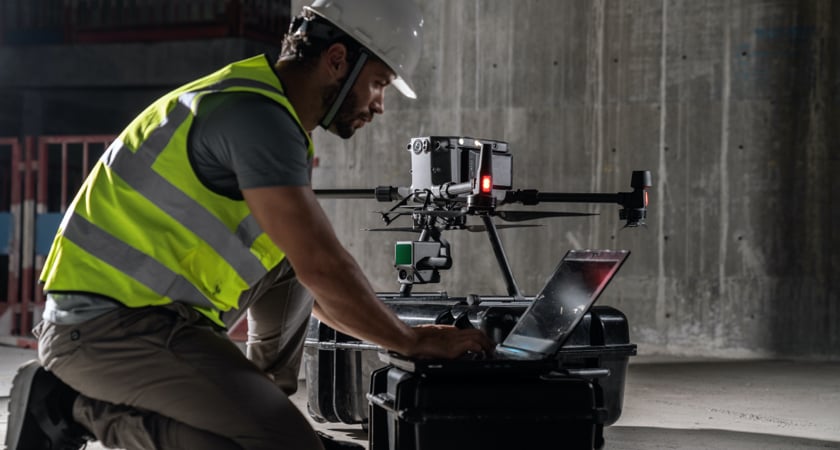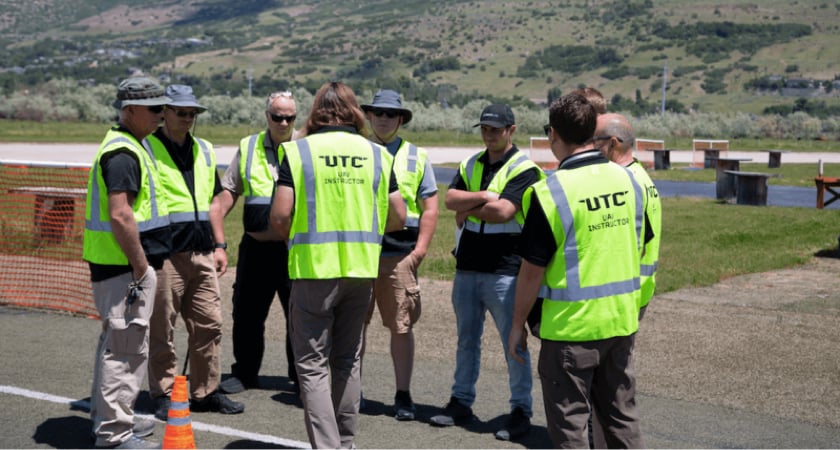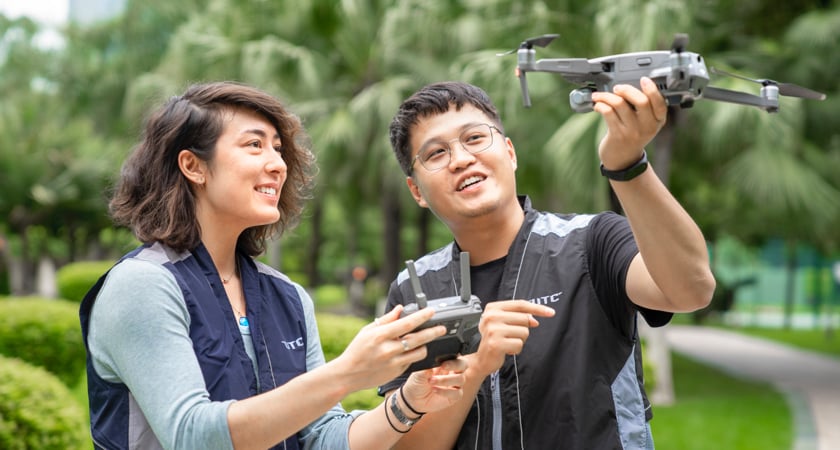From surveying construction sites to shooting Hollywood movies, drones are changing how work is done in a variety of applications, and it’s no wonder the commercial drone sector is rapidly on the rise.
For pilots looking to be part of this thriving industry, the journey begins with a clear understanding of the rules for being a compliant, responsible operator, and ultimately – getting the necessary training to help you become a qualified drone pilot. In the U.S. alone, there are more than 100,000 certified commercial drone pilots — and as more enterprises and organizations continue to adopt drone technology, the need for skilled drone operators will continue to rise.
Today’s commercial drone jobs
With drone adoption accelerating at a rapid pace — and expected to only increase — now is the time to enter the field. According to Business Insider, the drone services industry is projected to rise to $63.6 billion by 2025. None of this can be possible without drone pilots.
Drone pilots have to do everything from collecting visual, LiDAR, and thermal data to shooting striking photographs and films. Drones also help keep workers safe by allowing them to explore dangerous parts of a worksite, like underground mines, without actually setting foot there.
The list of industries that rely on drones to get the job done is long. Relevant sectors include:
- Surveying and site mapping: Drones and other UAVs have revolutionized the surveying industry by making it easy to cover large sites in short time frames and create detailed photogrammetric models.
- Construction: In addition to surveying sites, drones are being used by construction companies to collect data and construct 3D models of projects.
- Real estate: Drones are making virtual home and apartment tours possible, with everything from room-by-room videos to assist with interactive 3D models.
- Building inspection: UAVs help inspectors check up on the safety of a building without ever setting foot in it.
- Mining: Mines and quarries are simplifying tedious tasks like surveying and stockpile volume measurement, allowing workers to focus on extraction.
- Insurance: Some of the top insurance companies have begun using UAVs to gather information both pre-loss and post-loss. According to Deloitte, common examples include natural disaster monitoring, aerial site assessments that can identify risk to a property and inspecting a claim site for fraud.
- Archeology: Much like construction, mining or surveying in general, drones are used to visualize the full scope of a site and possibly identify artifacts that can’t be seen from a ground view.
- Entertainment: Did you know that 1 in 5 commercial drone licenses in the United States secured for the entertainment industry? The most common use of drones in this sector is filming live events, such as sporting events, according to AOPA.
- Public safety: Police and fire departments use drones to scout out an area before sending personnel in. UAVs can be equipped with thermal sensors that track where a fire is strongest. Drones have also been used effectively in search and rescue missions.

Do I need to obtain a commercial drone license?
In almost every case, no matter where you are in the world, the answer to this question will be an emphatic yes — unless you’re flying in very specific conditions, like indoors while conducting warehouse inventory inspection. Commercial drone use is typically defined to include any time you stand to profit from operating your drone. While not every country clarifies a difference between commercial and recreational drone use, registration of some kind is usually necessary to join the global drone pilot community.
The path from certification to a fledgling career in drones, however, may look different depending on your goals. For potential pilots looking for an entrepreneurial route, you can become a drone solution provider with RMUS, which not only supplies industrial drone equipment across the agriculture, energy, public safety sectors and more, but the company also offers a variety of training services that are specific to the customer’s drone program needs.
If you are looking for a more part-time approach, you can turn to a company like DroneBase, which helps pilots find jobs in their local area. To achieve this, you will need to have a commercial drone license, called the Part 107 License in the U.S., then create and upload your profile to their database so they can find you a suitable placement.
In other avenues, you can find jobs online via a simple search on a regular job site. Typical vacancies include aerial photography, real estate, property insurance, as well as more technical vacancies like construction, where drones are commonly used for the design and planning of new projects.
Commercial drone licenses around the world
Before you can join this global community of commercial drone operators, however, you need to know the rules of the game and follow the safety regulations designed to help pilots fly safely within their national airspace. Each nation has its own set of regulations regarding who can fly a drone commercially.
🇺🇸United States🇺🇸
In the U.S., the Federal Aviation Administration (FAA) is the governmental body that is responsible for regulating the national airspace, and classifies drone pilots into three categories:
- Hobbyists: Includes drone pilots flying for recreational purposes;
- Commercial users: Pilots flying with the intent of generating commercial value;
- Government users: Any drone pilots flying for a government entity such as fire department, police department, agency or similar
Establishing which type of classification you fit under will allow you to understand the rules and regulations that are applicable — with hobbyists subject to a lower level of oversight than the other two categories.
Commercial drone pilots are subject to the FAA’s Small UAS Rule (Part 107) — which states that commercial pilots must hold a Remote Pilot Certificate and register their UAV with the FAA. Other Part 107 rules specify the allowable weight of a UAV, as where your drone can go.
Notably, drones must weigh less than 55 pounds, including payload and must be kept within the pilot’s visual line of sight and in Class G airspace. The eligibility criteria to receive a Remote Pilot Certificate, include:
- Being 16 years of age or older;
- Passing the Part 107 test;
- The ability to read, speak and write English;
- The physical and mental condition to fly a drone safely
To begin the certification process, a pilot must begin by creating an Integrated Airman Certification and Rating Application (IACRA) profile.
From there, you’ll need to schedule an appointment with an FAA Knowledge Testing Center to take the Part 107 test. The exam covers multiple subjects, including:
- Restrictions and regulations;
- Operating requirements;
- The effects of weather on a UAS;
- Radio communication procedures;
- Emergency procedures;
- The impact of drugs and alcohol on flight ability;
- Maintenance and preflight inspection procedures
Once a pilot has passed the test, they should complete FAA Form 8710-13 and register in the FAA IACRA system. A printable remote pilot certificate will then be issued and emailed. Commercial drone pilots should keep this certificate in an accessible place at all times when working with a drone or other UAS. Each certificate is valid for two years, at which point a pilot will have to pass another knowledge test.
🇨🇦Canada🇨🇦
Commercial drone flying is far less regulated in Canada than in the U.S. or U.K. In fact, while a drone pilot certificate is required, Transport Canada makes no distinction between commercial and recreational use. There are, however, two different levels of certification.
For Basic Operations — which includes any flight more than 100 feet away from bystanders and in uncontrolled airspace — pilots need only take an online test, called the Small Basic Exam.
For all other flights — classified as Advanced Operations — pilots must complete a separate online test and complete a flight review. This is an in-person evaluation of your skills as a pilot, similar to a driver’s license test. This examination is administered by a certified flight reviewer who attended a drone flight school and has been approved by Transport Canada.
No matter what kind of certification you have, it’s essential that your drone pilot certificate is on your person at all times while operating a UAV.
🇪🇺European Union & UK🇬🇧
Starting in 2020, the EU and all its member nations divide drones into three distinct categories based on their weight and use. Now, as of December 31, 2020, the UK’s Civil Aviation Authority (CAA) is also switching from its own permissions system to the EU model.
The Open category covers most forms of commercial drone use. Open drones can’t fly over any “uninvolved people,” without exception — however past that there are subcategories based on the type of drone. Subcategory A2 drones can fly within 30 horizontal meters of uninvolved people, and get as close as 5 meters if using the low-speed mode function. However, only drones manufactured in 2021 or later are eligible.
For most commercial drones, Subcategory A3 rules apply. This class of drones can only fly in an area where uninvolved people and buildings are outside of your visual line of sight, typically about 150 meters.
The Specific and Certified categories, meanwhile, include drones and uses with a greater level of risk. Drones covered in the Specific category require specific authorization before any given flight. In some cases, however, a pilot need only declare their intention to fly in advance. For Certified category flights, both the drone and operator must have special licensing.
Once you’ve determined which category best describes your situation, you can begin the licensing process by registering with your area’s National Aviation Authority. Notably, each country in the EU has its own NAA (The UK’s licensing process is handled exclusively by CAA). From there, it’s on you to ensure your drone is properly insured in your country and take the test for your category. Each test has 40 multiple-choice questions. Potential subcategory A2 pilots also need to answer an additional 30 multiple-choice questions about subjects like mitigating ground risk.
Before switching to the EU model, the UK required drone users to apply for permission (or a license) for any commercial purposes or flights more than 400 feet above the ground and within a set distance of crowded areas.
For more information, we decode the new European drone regulations laid out by the European Union Aviation Safety Agency (EASA).
🇦🇺Australia🇦🇺
Commercial drone pilots in Australia must have a remote pilot licence, or RePL from the Civil Aviation Safety Authority. In addition, you or your employer must possess a remotely piloted operators certificate (ReOC) — which is for businesses who wish to use drones. Notably, none of these licensing requirements apply to a recreational user.
To obtain a RePL, pilots must first apply for an aviation reference number, a unique ID used by the government to identify pilots. From there, pilots must complete a required training protocol. Those with no previous experience must take a course with a certified training provider. For those who have some experience — such as some members of the military and those who have already completed an aviation theory course — a short competency test is the only requirement. A completed RePL can then be downloaded with a convenient iPhone or Android app.
Gain a Competitive Edge with Manufacturer-Certified Training
Getting your home country’s version of a professional drone license is only the first step to making yourself a desirable drone pilot candidate to recruiters.

In 2016, DJI founded the Unmanned Aerial System Training Center (UTC) — a global initiative designed to provide a practical UAS training platform that complies with industry standards. Since its inception, the UTC program has rapidly expanded to more than 200 training centers, training over 40,000 pilots worldwide including Mainland China, Hong Kong, Taiwan, Japan, Malaysia, the Netherlands, and the United States.
What sets UTC apart from other training programs, is that it’s the only manufacturer-certified training program in the market – meaning, trainees get access to:
- A professional curriculum that includes standard drone operation procedures using the latest DJI drone technology
- UTC’s global training network, delivering high quality service to all trainees
- DJI’s ecosystem, including continuous skills training, extensive drone knowledge resources and more
- An official manufacturer training certificate provided upon successful completion of the course
To further empower aspiring professional pilots across the globe, DJI, in partnership with RMUS, recently expanded its UTC program by opening eight training centers across the U.S., helping enterprises scale out their drone operations and providing pilots with an alternative avenue to develop advanced pilot skills.

Where to learn more:
- Contact DJI today, to explore the benefits of commercial drones.
- Subscribe to DJI Enterprise’s newsletter to stay tuned with the latest commercial drone news.
Sources:
https://www.aopa.org/news-and-media/all-news/2019/may/07/faa-forecast
https://www.faa.gov/uas/commercial_operators/become_a_drone_pilot/
https://tc.canada.ca/en/aviation/drone-safety/find-your-category-drone-operation#basic
https://www.casa.gov.au/drones/remote-pilot-licence#:~:text=A%20remote%20pilot%20licence%20



.png?width=300&name=FH2%20update%20(1).png)
-1.png?width=300&name=HS%20-%20Featured%20Images%20(3)-1.png)
